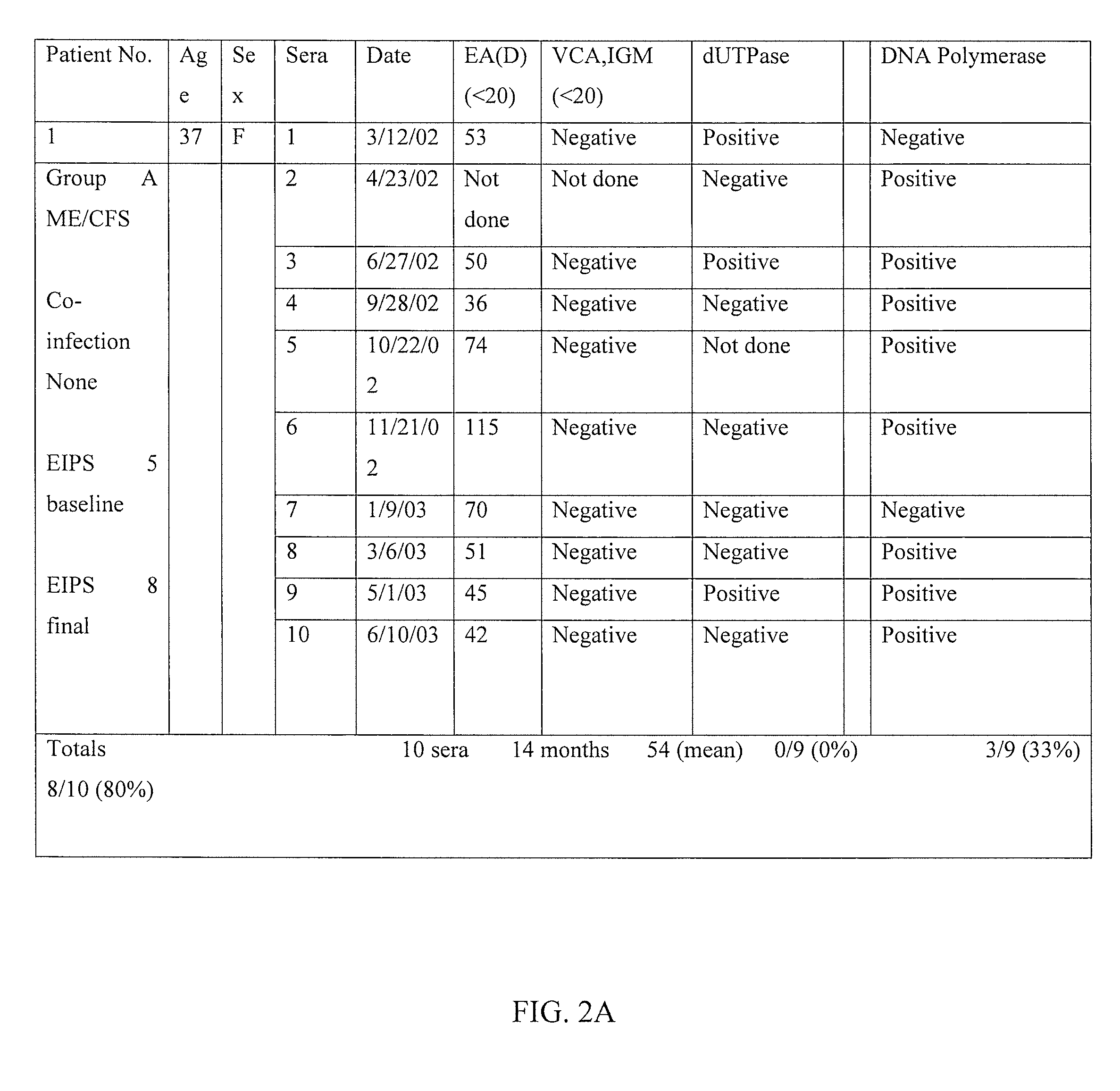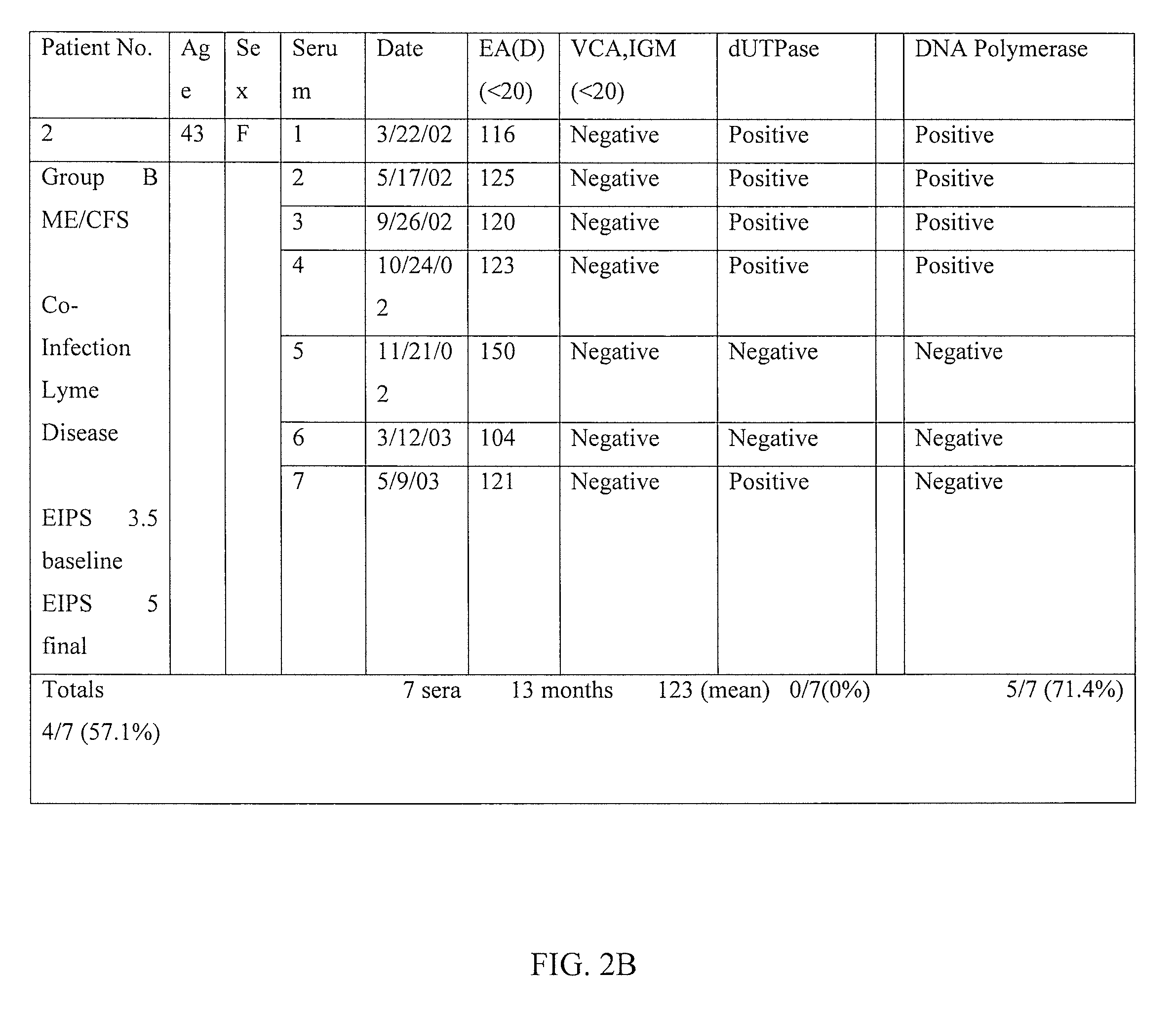Method of diagnosing and treating epstein barr virus-based myalgic encephalomyelitis chronic fatigue syndrome patients using a serum antibody assay
Inactive Publication Date: 2016-09-08
CFS
View PDF2 Cites 1 Cited by
- Summary
- Abstract
- Description
- Claims
- Application Information
AI Technical Summary
Benefits of technology
[0011]In yet another embodiment, a method of diagnosing and treating an Epstein-Barr virus subset of patients with Myalgic Encephalomyelitis-Chronic Fatigue Syndrome is disclosed and includes the steps of: 1) Identifying Epstein-Barr virus Abortive Lytic
Problems solved by technology
To date, evidence-based etiology or treatment has been elusive.
However, the disorder remains debilitating, complex and mysterious in origin, natural history, understanding and treatment.
While they may lead to modest short-term improvement, such treatments have proven generally ineffective in the long run.
As the underlying causes and distinctions among types of CFS patients have not previously been known, both observational and evidence-based trials have been misdirected or inappropriately planned.
While progress has been made to segregate certain groups of CFS patients and provide them with specific antiviral agents to alleviate the condition, for other CFS patients—namely those found to have herpes virus plus co-infections—no effective treatment option has been identified to date.
CFS is often characterized by abortive replication and an inability on the part of the patient to inactivate the CFS-causing agent by inducing, for instance, inactive herpes virus latency.
Per this hypothesis, CFS patients are believed to continue EBV, HCMV and HHV6 herpes virus replication, and do not achieve the viral latency necessary for recovery.
While CFS patients classified with EBV, HCMV and HHV6 in single or multiple infections without co-infection have been diagnosed and treated successfully, that is not the case to date for the
Method used
the structure of the environmentally friendly knitted fabric provided by the present invention; figure 2 Flow chart of the yarn wrapping machine for environmentally friendly knitted fabrics and storage devices; image 3 Is the parameter map of the yarn covering machine
View moreImage
Smart Image Click on the blue labels to locate them in the text.
Smart ImageViewing Examples
Examples
Experimental program
Comparison scheme
Effect test
 Login to View More
Login to View More PUM
| Property | Measurement | Unit |
|---|---|---|
| Time | aaaaa | aaaaa |
| Time | aaaaa | aaaaa |
| Mass | aaaaa | aaaaa |
Login to View More
Abstract
A method of diagnosing a subset of Epstein Barr Virus, Myalgic Encephalomyelitis Chronic Fatigue Syndrome (ME/CFS) patients through a multi-prong clinical/serological analysis is provided wherein Epstein Barr Virus Abortive Lytic Replication (EBV) is determined by detecting the presence of BMRF1 in serum antibody assays. A method of treating patients diagnosed with Epstein Barr Virus Abortive Lytic Replication (EBV), Myalgic Encephalomyelitis Chronic Fatigue Syndrome (ME/CFS) with specific antiviral nucleosides is also provided, to alleviate the condition.
Description
CROSS-REFERENCE TO RELATED APPLICATIONS[0001]This application claims the benefit of U.S. provisional application Ser. No. 62 / 110,562 filed Feb. 1, 2015 the disclosure of which is hereby incorporated in its entirety by reference herein.TECHNICAL FIELD[0002]The present invention relates to a method of classifying, diagnosing and treating a subset of Epstein Barr Virus, Myalgic Encephalomyelitis Chronic Fatigue Syndrome (ME / CFS) or Systemic Exertion Intolerance Disease (SEID), patients. In particular, the invention relates to a protocol for classifying an appropriate subset of patients through a multi-prong clinical / serological analysis, diagnosing patients with Epstein Barr virus (EBV) as the specific causal agent of chronic fatigue syndrome through the use of an antibody to EBV DNA Polymerase processivity factor, BMRF1, as a molecular marker and further treating diagnosed patients with specific antiviral nucleosides which alleviate the condition.BACKGROUND[0003]Chronic Fatigue Syndro...
Claims
the structure of the environmentally friendly knitted fabric provided by the present invention; figure 2 Flow chart of the yarn wrapping machine for environmentally friendly knitted fabrics and storage devices; image 3 Is the parameter map of the yarn covering machine
Login to View More Application Information
Patent Timeline
 Login to View More
Login to View More IPC IPC(8): G01N33/569A61K31/4178A61K31/675A61K31/195
CPCG01N33/56994A61K31/195G01N2333/05A61K31/675A61K31/4178A61K31/52A61K31/522A61K31/662A61K31/7056G01N33/573G01N33/6863A61K2300/00
Inventor LERNER, A. MARTIN
Owner CFS
Features
- R&D
- Intellectual Property
- Life Sciences
- Materials
- Tech Scout
Why Patsnap Eureka
- Unparalleled Data Quality
- Higher Quality Content
- 60% Fewer Hallucinations
Social media
Patsnap Eureka Blog
Learn More Browse by: Latest US Patents, China's latest patents, Technical Efficacy Thesaurus, Application Domain, Technology Topic, Popular Technical Reports.
© 2025 PatSnap. All rights reserved.Legal|Privacy policy|Modern Slavery Act Transparency Statement|Sitemap|About US| Contact US: help@patsnap.com



